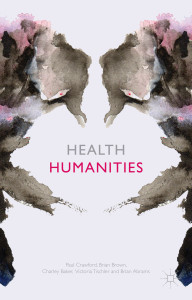Health Humanities Paul Crawford, Brian Brown, Charley Baker, Victoria Tischler and Brian Abrams (London: Palgrave, 2015)
Reviewed by Dr Maria Vaccarella, Postdoctoral Research Fellow in Medical Humanities, Centre for the Humanities and Health, King’s College London
In her foundational study Manifestoes: Provocations of the Modern (1999), Janet Lyon explains that “the manifesto both generates and marks a break in history: it is both a trace and a tool of change” (16). In drafting this manifesto for the health humanities, Paul Crawford, Brian Brown, Charley Baker, Victoria Tischler and Brian Adams provide exactly this combination for change: Health Humanities (2015) traces the long-standing interplay of arts, humanities and healthcare, as well as advocating a reconceptualization of this very interaction. Scholars and practitioners in the field will be familiar with Crawford’s argument for an expansion of the medical humanities to include non-medical carers involved in the provision of health and wellbeing. What emerges more clearly from this book is a stance against “medicalised humanities”: as paradoxical as it sounds, humanists can end up privileging medical understandings of health and wellbeing issues, especially when constantly pressurized to justify their own research topics and methods, according to well-established research patterns, originated in the biomedical sciences.
This reflection on what counts as reliable research and interventions in humanities-based healthcare activities (chapter 7) is by far the most valuable contribution of this book to existing scholarship. The authors move from a careful examination of the shortcomings of evidence based medicine – unfortunately sometimes still showcased as the golden standard of health-related research – to an exploration of practice-based evidence, a helpful framework for bringing into play the positive results of recent challenges to traditional research, e.g. action research, patient advocacy, etc. This bottom-up shift in perspective will be most helpful in redressing the benefits of humanistic approaches to health-related issues, as well as dismantling the power imbalance between researchers and participants. The notion of evidence is not naively dismissed as inapplicable in the humanities; rather, it is presented as a much more nuanced concept than what is usually encountered in the biomedical sciences. As a consequence, if we want to collate results of humanities-based healthcare activities with a view of improving healthcare provision and policy, then we should reflect on an adequate methodology, given the limitations of systematic reviews and meta-analyses in this area. Crawford and colleagues suggest metasynthesis as a better way of making sense of the diverse inputs that the arts and humanities are likely to engender. Engaging in metasyntheses could also facilitate the emergence of a new, more cogent role for humanities academics interested in health-related issues, whom the authors describe as often wary of pushing their ideas into practice. A further advantage of a stronger engagement with creative practice is a resulting sense of mutual (one would be tempted to add, non-medicalised) recovery and community-building: to quote from the book, “there is a need to bring together diverse academic and community partners to share insights, approaches, methods and analytic tools in order to mobilise the concept and develop creative practice as mutual recovery to better connect communities for physical and mental health and well-being.” (142)
This invitation to fully embrace creativity is offered at the end of a survey of previous, more or less deliberate, preparatory work in a range of disciplines, from anthropology and the study of culture (chapter 2), through applied literature (chapter 3), narrative and applied linguistics (chapter 4), to performing and visual arts (chapters 5 and 6, respectively). The authors provide an introduction to the field under scrutiny in each chapter and then list a wide-ranging selection of its applications in health-related settings. There are nonetheless some inexplicably neglected areas, e.g. the role of performing arts in bringing about Patient Educators and Medical Readers’ Theatre (the benefits of which reach far beyond medical schools), or patients’ and carers’ graphic memoirs as a vivid example of the transformative, if not strictly therapeutic, potential of the visual arts. The internal organization of these chapters is also regrettably uneven. By way of an example, the chapter on anthropology ends with a most helpful set of questions, inspired by Arthur Kleinman’s exploratory models, to assist health humanities practitioners in taking stock of results from a cognate discipline to improve their own approach to patients. However, if readers expect a similarly pragmatic conclusion to all other chapters, they are bound to be disappointed. Of course, reducing innovative concepts to a list of questions could be regarded as a tedious exercise; but at least some of the disciplinary fields reviewed here (e.g. narrative medicine) would have easily yielded practical guidelines, a surely welcome gesture towards those informal carers that the authors make a point of engaging with to a greater extent. In this regard, the concise case studies boxes distributed throughout the text precisely perform this function of providing snapshots of interventions, informed by the theoretical debates surveyed in the chapters. They are so effective in showcasing the potential of the health humanities approach that one regrets that they have not been used more consistently throughout the volume.
The central tenet of Health Humanities that “the majority of healthcare and the generation of health and well-being is non-medical” (153) is indeed fascinating, especially because it could potentially evoke completely different scenarios in the context of global health. This looks like the ultimate challenge to the authors of this volume and all other practitioners of the health humanities: how can their promise of inclusiveness and internationalisation be predicated on a global scale, so that their envisioned maximisation of benefits to practitioners, informal carers and patients/carers responds to worldwide health-related needs? The manifesto has been produced; we now look forward to the change.
